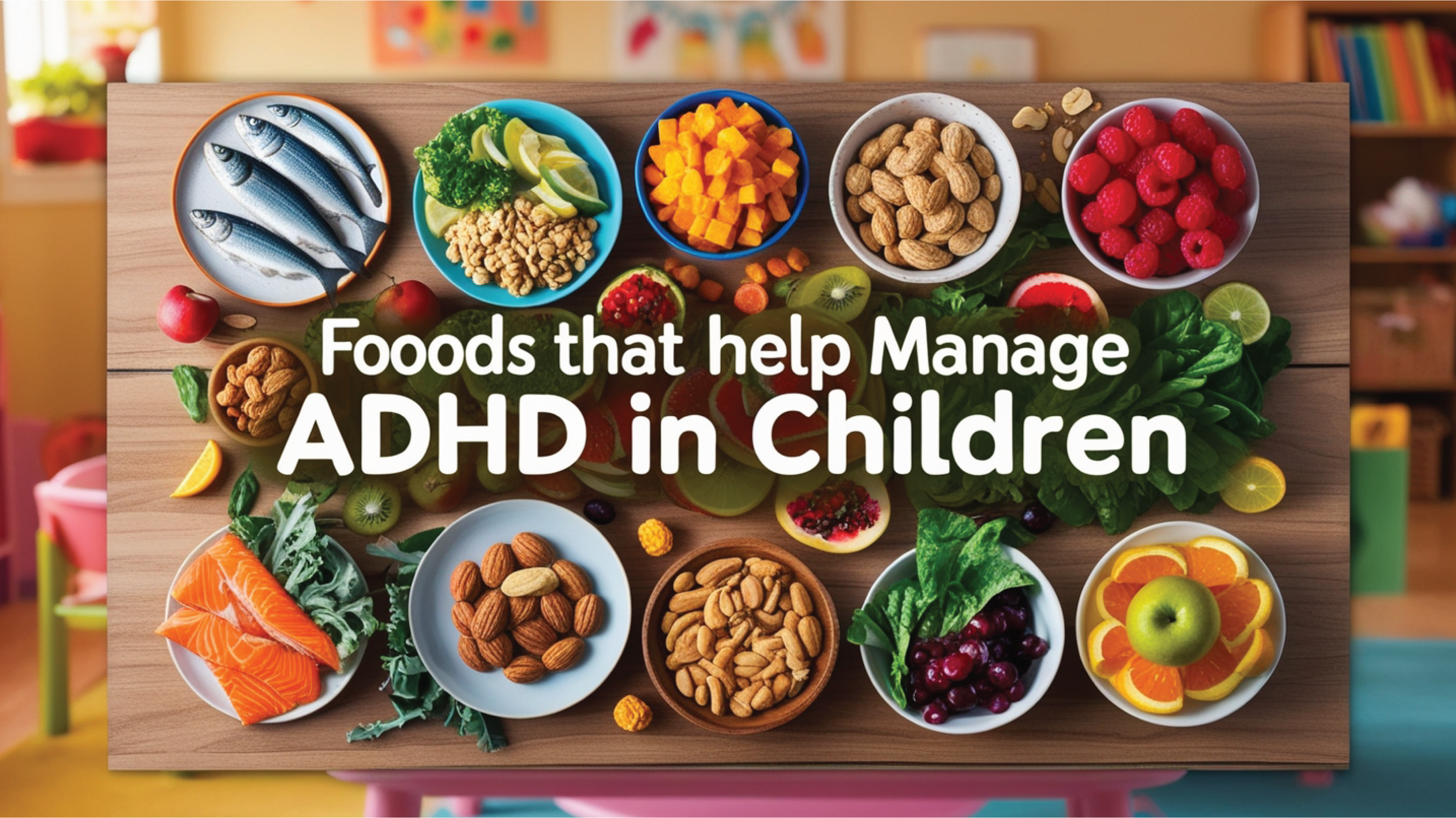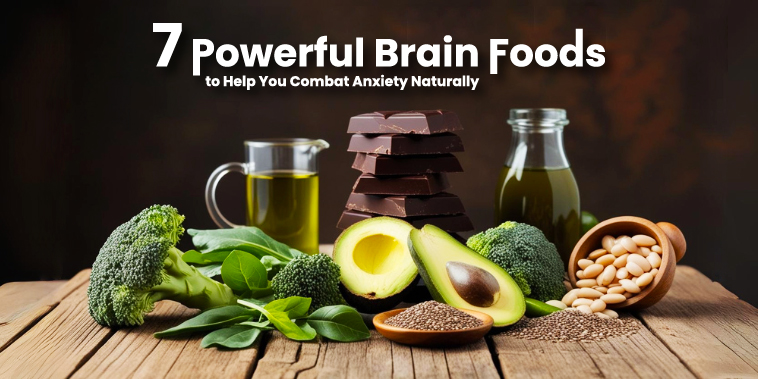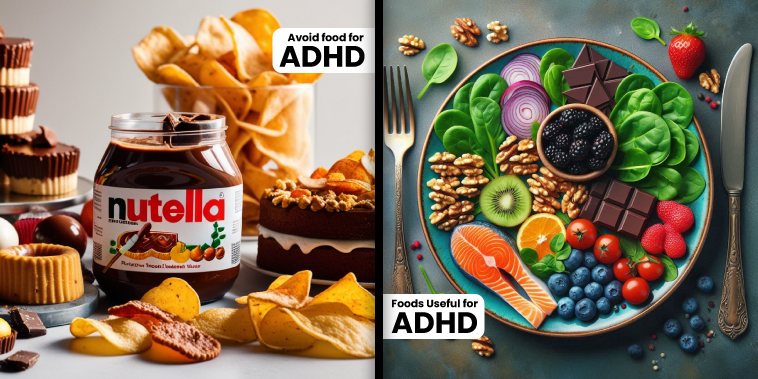Book Appointment Now

Foods That Help Manage ADHD in Children
Attention Deficit Hyperactivity Disorder (ADHD) is a condition that affects many children, influencing their ability to focus, control impulses, and manage their energy levels. While medication and therapy are often essential for managing ADHD symptoms, nutrition plays a significant role in overall brain health and behavior. In this blog, we will explore the foods that may help manage ADHD symptoms in children, backed by research and practical advice for parents.
Understanding ADHD and Nutrition
ADHD symptoms can manifest in various ways, including inattention, hyperactivity, and impulsivity. These symptoms can significantly impact a child’s academic performance, social interactions, and overall quality of life. Emerging research suggests that certain dietary choices can either exacerbate or alleviate these symptoms. Nutrients found in specific foods can support brain function and emotional well-being.
The Role of Omega-3 Fatty Acids
Omega-3 fatty acids, particularly EPA and DHA, are essential for brain health. They are crucial for maintaining the structure of brain cell membranes and play a significant role in neurotransmitter function. Studies have shown that children with ADHD often have lower levels of omega-3 fatty acids in their diets.
Sources of Omega-3 Fatty Acids:
Fatty Fish: Salmon, mackerel, sardines, and trout are excellent sources.
Flaxseeds and Chia Seeds: These plant-based sources are high in ALA, a type of omega-3.
Walnuts: A great snack option that packs a healthy dose of omega-3s.
Incorporating these foods into your child’s diet can help improve concentration and reduce hyperactivity.
Whole Grains and Complex Carbohydrates
Complex carbohydrates, found in whole grains, help to maintain steady blood sugar levels. Unlike simple carbohydrates, which can lead to spikes and crashes in energy and mood, complex carbs release glucose slowly into the bloodstream, promoting stable energy levels.
Sources of Whole Grains
Brown Rice: A versatile side dish that pairs well with many meals.
Oats: A healthy breakfast option that can be customized with fruits and nuts.
Whole Wheat Bread and Pasta: Opt for these instead of white bread for better nutrition.
Including whole grains in your child’s meals can enhance focus and minimize mood swings.
Protein-Packed Foods
Protein is essential for neurotransmitter production, which regulates mood and behavior. Including adequate protein in your child’s diet can support their ability to concentrate and control impulses.
Sources of Protein:
Lean Meats: Chicken, turkey, and lean beef are great options.
Fish and Eggs: Both are excellent sources of high-quality protein.
Legumes and Beans: Lentils, chickpeas, and black beans provide plant-based protein.
Aim to include a source of protein in every meal to help sustain energy and focus throughout the day.
Fruits and Vegetables
Fruits and vegetables are rich in vitamins, minerals, and antioxidants, all of which are vital for overall health. Certain nutrients, such as magnesium, zinc, and iron, have been linked to improved attention and behavior in children with ADHD.
Fruits and Vegetables to Include:
Leafy Greens: Spinach, kale, and Swiss chard are rich in magnesium.
Berries: Blueberries, strawberries, and blackberries are packed with antioxidants.
Citrus Fruits: Oranges and grapefruits provide vitamin C, which is important for neurotransmitter function.
Encourage your child to eat a variety of colorful fruits and vegetables to ensure they get a broad spectrum of nutrients.
The Power of Probiotics
Recent research suggests that gut health can influence mental health, including ADHD symptoms. Probiotics, found in fermented foods, can promote a healthy gut microbiome, which may play a role in mood regulation.
Sources of Probiotics:
Yogurt: Opt for plain, unsweetened varieties to avoid added sugars.
Kefir: A fermented dairy drink that is rich in probiotics.
Sauerkraut and Kimchi: Fermented vegetables that can add flavor and nutrients to meals.
Incorporating probiotic-rich foods into your child’s diet may help improve their emotional regulation and cognitive function.
Limiting Processed Foods and Sugar
While certain foods can help manage ADHD symptoms, others can exacerbate them. Highly processed foods, artificial additives, and excessive sugar can lead to increased hyperactivity and decreased focus.
Foods to Limit:
Sugary Snacks: Candy, cookies, and sugary cereals can lead to energy spikes and crashes.
Artificial Additives: Some studies suggest that artificial colors and preservatives may worsen ADHD symptoms.
Fast Food: Often high in unhealthy fats and sugars, fast food can negatively impact behavior.
Encouraging your child to eat whole, unprocessed foods can make a significant difference in their behavior and attention levels.
Meal Planning Tips for ADHD
Creating a balanced diet for your child can seem overwhelming, but with some planning and creativity, it can be manageable. Here are some tips to help you get started:
1. Plan Ahead: Create a weekly meal plan that includes a variety of foods. This can help you avoid last-minute unhealthy choices.
2. Involve Your Child: Allow your child to help with meal planning and preparation. This can encourage them to try new foods and take an interest in their diet.
3. Healthy Snacks: Keep healthy snacks on hand, such as fruits, nuts, yogurt, and cut-up vegetables. This can help curb unhealthy cravings.
4. Stay Hydrated: Ensure your child drinks plenty of water throughout the day. Dehydration can affect concentration and energy levels.
5. Limit Screen Time During Meals: Encourage family meals without screens to promote mindful eating and communication.
6. Be Patient: It may take time for your child to adjust to new foods and dietary changes. Keep offering a variety of options without pressure.
Consulting a Professional
While dietary changes can be beneficial, it’s essential to consult with a healthcare professional, such as a pediatrician or a registered dietitian, before making significant changes to your child’s diet. They can provide tailored advice and ensure that your child’s nutritional needs are met.
Conclusion
Managing ADHD in children involves a comprehensive approach that includes therapy, medication, and nutrition. By incorporating nutrient-rich foods into your child’s diet, you can help support their brain health and potentially reduce ADHD symptoms. While there is no one-size-fits-all solution, a balanced diet focused on whole foods, healthy fats, proteins, and plenty of fruits and vegetables can make a meaningful difference. Remember, small changes can lead to significant improvements, and fostering a healthy relationship with food can benefit your child in many ways.
With patience and dedication, you can help your child thrive.



